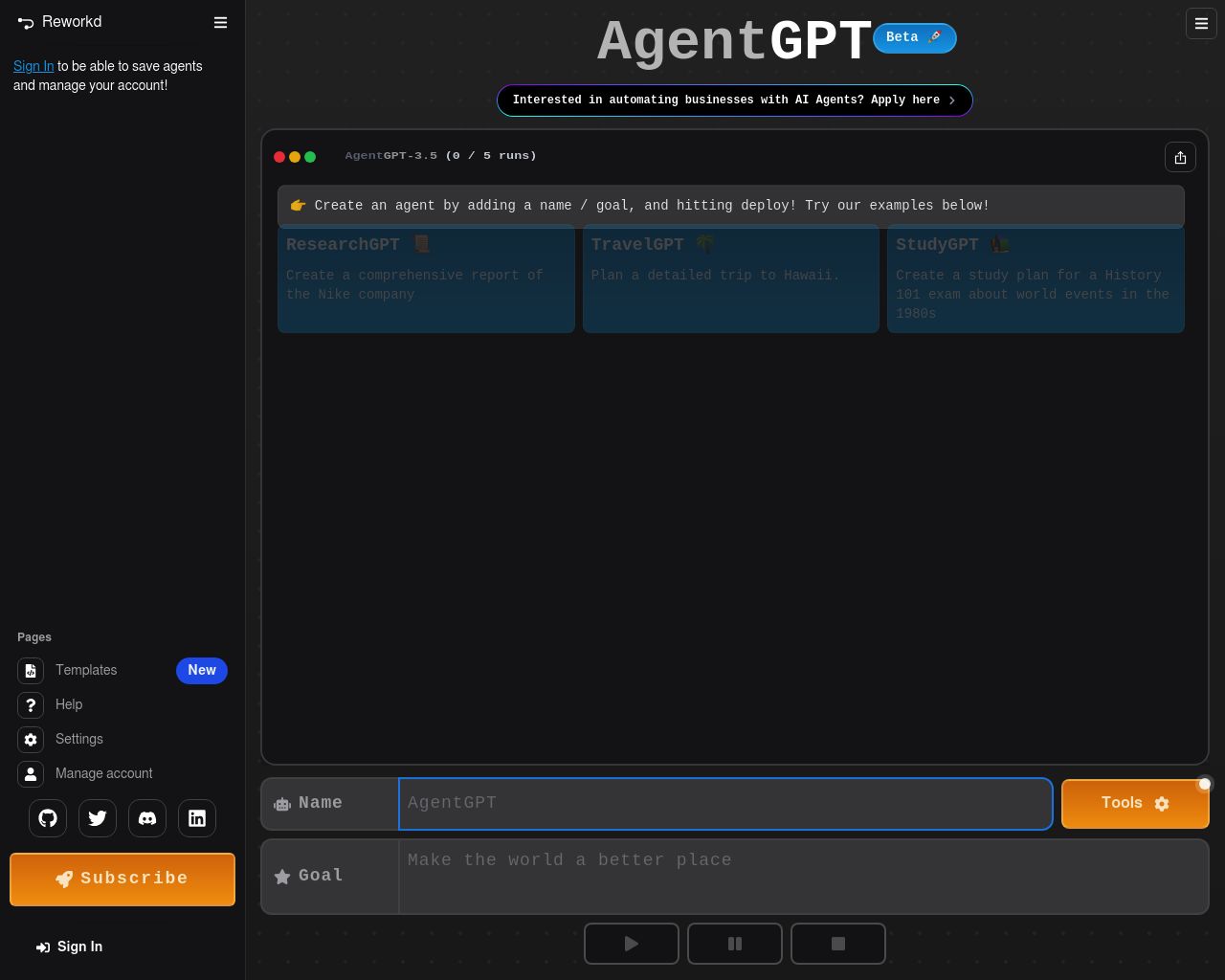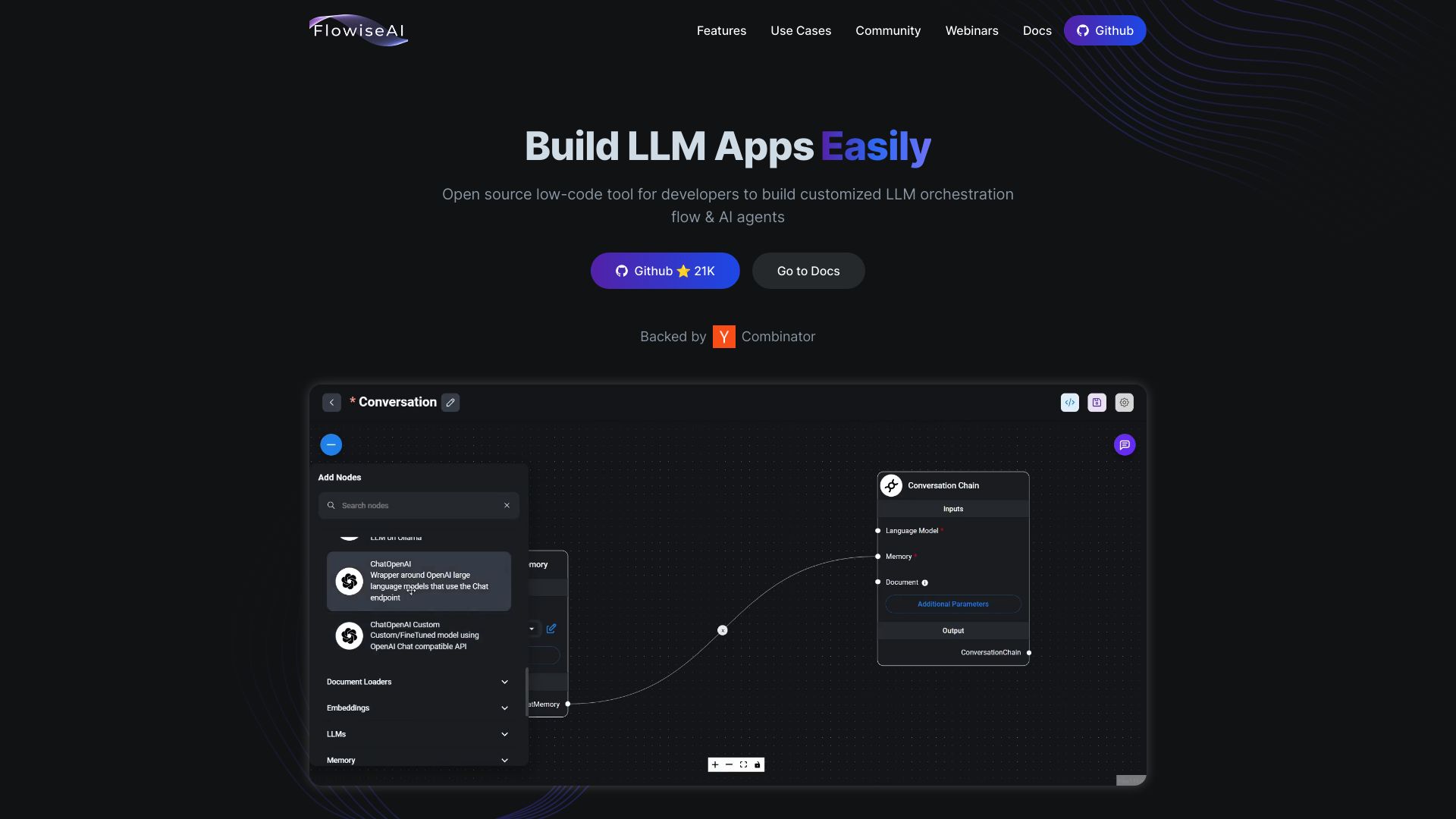AgentGPT vs. FlowiseAI: Comparing AI Development Platforms
AI agent development platforms are revolutionizing how businesses and developers create intelligent, autonomous systems. AgentGPT vs. FlowiseAI stand out as powerful tools in this space, each offering unique approaches to AI creation. AgentGPT excels in building goal-oriented agents capable of complex problem-solving, while FlowiseAI provides a low-code platform for rapid LLM application development.
This comparison delves into the strengths and limitations of both platforms, exploring their core features, development approaches, and potential use cases. We’ll also introduce SmythOS, a comprehensive solution that combines the best aspects of both tools while addressing their shortcomings, providing readers with a clear understanding of the optimal choice for their AI development needs.
AgentGPT Overview
AgentGPT empowers developers to build and deploy AI agents capable of autonomously executing complex tasks. This open-source platform leverages advanced language models to create agents that can research, analyze, and solve problems without constant human oversight.


AgentGPT’s core strength lies in its ability to handle goal-oriented tasks. Unlike traditional chatbots, these agents break down complex objectives into manageable steps, execute them sequentially, and adapt their approach based on intermediate results. This makes AgentGPT particularly valuable for tasks requiring sustained effort and dynamic problem-solving.
AgentGPT’s core strength lies in its ability to handle goal-oriented tasks. Unlike traditional chatbots, these agents break down complex objectives into manageable steps, execute them sequentially, and adapt their approach…
The platform offers key features that enhance its utility. Vector databases enable long-term memory storage, allowing agents to reference past interactions and maintain context over extended periods. AgentGPT also supports multiple languages through dynamic translations, broadening its potential user base. For developers, the platform provides customization options for AI models and integrates with tools like LangChain for expanded capabilities.
While AgentGPT offers powerful functionality, it does have limitations. The platform currently lacks a visual builder or no-code editor, which may present a barrier for non-technical users. Additionally, features like multi-agent collaboration and advanced analytics are not prominently highlighted, potentially limiting its application in complex enterprise scenarios.
AgentGPT positions itself as a flexible tool for AI development, bridging the gap between sophisticated language models and practical applications. Its open-source nature encourages community contributions, fostering ongoing improvements and adaptations to emerging use cases. For developers and businesses looking to harness the power of autonomous AI agents, AgentGPT provides a solid foundation with room for growth and customization.
FlowiseAI Overview
FlowiseAI empowers developers to create customized large language model (LLM) orchestration flows and AI agents through an open-source, low-code platform. This tool simplifies the process of building complex AI applications, making it accessible to a broader range of users without sacrificing functionality.


FlowiseAI’s low-code interface features drag-and-drop functionality, enabling rapid prototyping and deployment of sophisticated LLM-based applications. Developers can customize orchestration flows to fit specific needs across various domains, from document analysis to customer support. The platform supports integration with multiple document loaders, vector databases like Pinecone, and various data types including PDFs, web pages, and CSV files.
FlowiseAI empowers developers to create customized large language model (LLM) orchestration flows and AI agents through an open-source, low-code platform.
At the core of FlowiseAI lies its agent and chain system. This modular approach allows developers to link various nodes such as document loaders, text splitters, and LLMs to create complex workflows. The platform includes pre-built templates and tools for creating LLM applications, streamlining the development process.
While FlowiseAI offers powerful features for AI development, it may present challenges for users seeking extensive no-code options or advanced debugging tools. The platform’s focus on LLM orchestration and AI agent creation might require some technical knowledge, potentially limiting its accessibility to complete beginners. Additionally, the open-source nature of FlowiseAI means that users may need to rely on community support for troubleshooting and updates.
FlowiseAI’s vision centers on democratizing AI development by lowering the barrier to entry. By providing an open-source, low-code platform, it aims to enable more individuals and organizations to harness the power of large language models. This approach positions FlowiseAI as a valuable tool for developers and organizations looking to implement customized AI solutions efficiently and cost-effectively.
Feature Comparison
AgentGPT and FlowiseAI offer different approaches to AI agent development, each with distinct strengths and limitations. AgentGPT excels in creating autonomous, goal-oriented AI agents capable of complex problem-solving. Its use of vector databases for long-term memory storage enables agents to maintain context over extended periods, enhancing their ability to handle sustained tasks. FlowiseAI, on the other hand, provides a low-code platform with drag-and-drop functionality, making it more accessible for rapid prototyping and deployment of LLM-based applications.
A key difference lies in their core components. AgentGPT lacks a visual builder or no-code editor, potentially limiting its accessibility to non-technical users. FlowiseAI addresses this gap with its intuitive interface, allowing for easier customization of LLM orchestration flows. However, AgentGPT’s focus on autonomous agent creation may offer more sophisticated AI behaviors for complex tasks. In terms of security, neither platform prominently highlights advanced features like constrained alignment or comprehensive data encryption, which could be a concern for enterprise-level deployments.
Feature Comparison Table
| AgentGPT | FlowiseAI | SmythOS | |
|---|---|---|---|
| CORE FEATURES | |||
| Hosted Agents (Dev, Production) | ✅ | ❌ | ✅ |
| Environments (Dev, Production) | ✅ | ❌ | ✅ |
| Visual Builder | ❌ | ✅ | ✅ |
| No-Code Options | ❌ | ✅ | ✅ |
| Explainability & Transparency | ❌ | ✅ | ✅ |
| Debug Tools | ✅ | ❌ | ✅ |
| Multi-Agent Collaboration | ✅ | ❌ | ✅ |
| Human-AI Interaction | ❌ | ✅ | ✅ |
| Audit Logs for Analytics | ✅ | ❌ | ✅ |
| Work as Team | ✅ | ❌ | ✅ |
| SECURITY | |||
| Constrained Alignment | ❌ | ❌ | ✅ |
| OAuth | ✅ | ❌ | ✅ |
| IP Control | ❌ | ❌ | ✅ |
| COMPONENTS | |||
| Foundation AIs | ❌ | ✅ | ✅ |
| Zapier APIs | ✅ | ❌ | ✅ |
| Classifiers | ✅ | ❌ | ✅ |
| Data Lakes | ❌ | ❌ | ✅ |
| DEPLOYMENT OPTIONS (EMBODIMENTS) | |||
| Staging Domains | ❌ | ❌ | ✅ |
| Production Domains | ❌ | ❌ | ✅ |
| Deploy as Scheduled Agent | ❌ | ❌ | ✅ |
| DATA LAKE SUPPORT | |||
| Hosted Vector Database | ✅ | ❌ | ✅ |
| Sitemap Crawler | ❌ | ❌ | ✅ |
| YouTube Transcript Crawler | ❌ | ❌ | ✅ |
| Word File Support | ✅ | ❌ | ✅ |
Best Alternative to AgentGPT and FlowiseAI
SmythOS emerges as the superior alternative to AgentGPT and FlowiseAI, offering a comprehensive platform for AI agent development and deployment. Our solution combines the strengths of both competitors while addressing their limitations, providing users with a powerful, versatile, and user-friendly experience.
Unlike AgentGPT’s lack of visual builder and FlowiseAI’s limited deployment options, SmythOS offers a robust drag-and-drop interface that simplifies the creation of complex AI workflows. This feature democratizes AI development, making it accessible to users with varying levels of technical expertise. We provide pre-built API integrations and templates, significantly reducing setup time and allowing users to focus on innovation rather than implementation details.
SmythOS offers a robust drag-and-drop interface that simplifies the creation of complex AI workflows. This feature democratizes AI development, making it accessible to users with varying levels of technical expertise.
SmythOS excels in multi-agent orchestration, enabling teams of AI agents to collaborate on complex tasks. This capability enhances the efficiency and scalability of AI implementations, surpassing the limited multi-agent support of AgentGPT and FlowiseAI. Our platform also offers superior deployment flexibility, allowing agents to be integrated seamlessly into existing systems across various platforms, including Google Vertex, Microsoft Copilot, and Amazon Web Services Bedrock.
Security and scalability set SmythOS apart from its competitors. We prioritize features like constrained alignment and comprehensive data encryption, addressing enterprise-level concerns that AgentGPT and FlowiseAI may overlook. Our platform is designed to handle enterprise-scale deployments while maintaining performance and security, making it an ideal choice for businesses of all sizes.
With SmythOS, users gain access to a wide array of AI models from different providers, extensive API integrations, and advanced features like hosted vector databases and multimodal support. These capabilities, combined with our intuitive interface and robust debugging tools, make SmythOS the most comprehensive and user-friendly option for AI agent development and deployment. By choosing SmythOS, users can harness the full potential of AI, transforming their workflows and driving significant advancements across various industries.
Conclusion
AgentGPT and FlowiseAI offer unique approaches to AI agent development, each with distinct strengths. AgentGPT excels in creating autonomous, goal-oriented agents for complex problem-solving, while FlowiseAI provides a low-code platform for rapid prototyping of LLM-based applications. However, both platforms have limitations that may not fully meet the needs of all users.
SmythOS emerges as the superior choice, offering a comprehensive solution that combines the best features of both platforms and addresses their shortcomings. Our drag-and-drop interface surpasses FlowiseAI’s low-code approach, making AI development accessible to users of all skill levels. Unlike AgentGPT, we provide a visual builder and no-code editor, significantly lowering the barrier to entry for non-technical users.
Our platform stands out with its extensive integration ecosystem, supporting over 300,000 integrations and a wide range of AI models. This versatility allows users to create sophisticated AI workflows that seamlessly connect to various data sources, APIs, and tools. SmythOS also excels in deployment flexibility, enabling users to deploy AI agents across multiple platforms and services with our “Create Once, Deploy Anywhere” approach.
To experience the power of SmythOS and revolutionize your AI development process, create a free account today. Our platform offers unlimited agent creation with a 30-day money-back guarantee, allowing you to explore AI automation without risk. Dive into our comprehensive documentation to unlock the full potential of SmythOS and take the first step towards AI-powered success for your business.
Last updated:
Disclaimer: The information presented in this article is for general informational purposes only and is provided as is. While we strive to keep the content up-to-date and accurate, we make no representations or warranties of any kind, express or implied, about the completeness, accuracy, reliability, suitability, or availability of the information contained in this article.
Any reliance you place on such information is strictly at your own risk. We reserve the right to make additions, deletions, or modifications to the contents of this article at any time without prior notice.
In no event will we be liable for any loss or damage including without limitation, indirect or consequential loss or damage, or any loss or damage whatsoever arising from loss of data, profits, or any other loss not specified herein arising out of, or in connection with, the use of this article.
Despite our best efforts, this article may contain oversights, errors, or omissions. If you notice any inaccuracies or have concerns about the content, please report them through our content feedback form. Your input helps us maintain the quality and reliability of our information.
